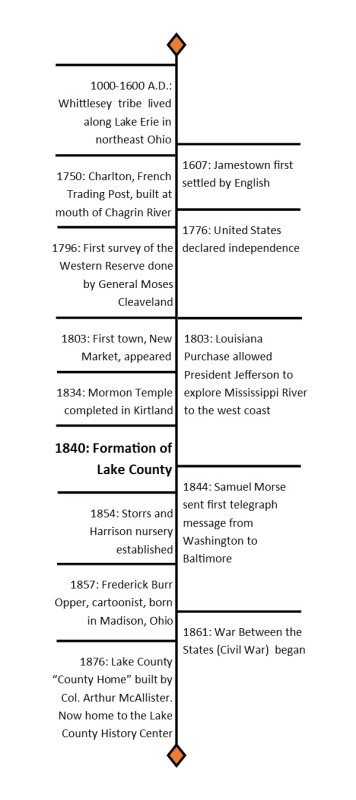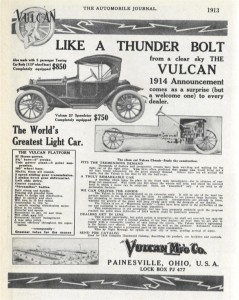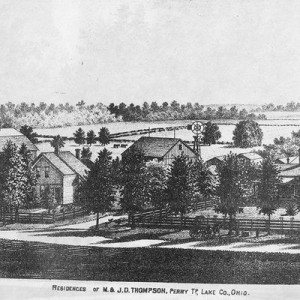 From 1000-1600 A.D., the Whittlesey Native American Tribe lived in northeast Ohio. They lived in communities and relied on their agricultural skills for survival. In 1796, what was known as the Western Reserve to the colonies was sold to the Connecticut Land Co. and then to individuals that eventually settled here. They left their comfortable style of living and moved to the wilderness of northeast Ohio. Among these early settlers were Samuel and Hannah Huntington, arriving in 1808. Samuel eventually served as Ohio Governor, leaving Hannah and her children to bare the wilderness by themselves. Survival was the most important thing in their lives, and was a constant struggle.
From 1000-1600 A.D., the Whittlesey Native American Tribe lived in northeast Ohio. They lived in communities and relied on their agricultural skills for survival. In 1796, what was known as the Western Reserve to the colonies was sold to the Connecticut Land Co. and then to individuals that eventually settled here. They left their comfortable style of living and moved to the wilderness of northeast Ohio. Among these early settlers were Samuel and Hannah Huntington, arriving in 1808. Samuel eventually served as Ohio Governor, leaving Hannah and her children to bare the wilderness by themselves. Survival was the most important thing in their lives, and was a constant struggle.
By the 1830’s the Western Reserve had changed a great deal. Homes were much more comfortable and there were more people in the area due to improved transportation. Cabin industry was flourishing and mills were springing up and making life much easier. Other industries such as Arcole Furnace were beginning. This was also a time for the flood of religious fervor throughout the country and here in Lake Co. Joseph Smith, Jr. also traveled to Kirtland and the Kirtland Temple was built by many of his followers. Jonathan Goldsmith became a master architect of the area, bringing with him the style of New England. His Greek Revival homes led way to the estate era and laid the groundwork for Edward Moore and Henry Everette to bring the InterUrban railroad to Lake County.
In 1840, Lake County was now a reality. Painesville was made the county seat and was busier than Cleveland. Arcole Furnace Company was operating, and stagecoaches were traveling from Buffalo and Detroit through the county. The eastern end of the county was the doorway to a life here. The county was also beginning to take an active part in the abolitionist movement.
Fairport had seen a great deal of action as a harbor in Lake County. It had been extremely active with transporting goods and materials out of the area and by bringing in goods that were needed. By the 1880s the harbor was slowing down. The equipment was getting old and the railroad was handling the imports and exports. Then things changed when iron ore was found in Michigan and in 1885 new docks were constructed and the old railroad was reconstructed. A flood of European immigrants came to fill the jobs, for there had been more work than men.
At the turn of the century, many of the wealthy Cleveland men were building their summer estates here in Lake Co. There were the Coulbys, Moores, Rockefeller, Squires and many others that made their money in oil, shipping, railroad, and manufacturing that came to spend their money here. With the InterUrban installed, Lake County homes had electricity and were only 1 hour away from Cleveland’s city center. The women and children of the family could travel independently for shopping and school making estate life in the country very appealing.
World War I, the Depression, and World War II all had their effects on the country, but Lake County didn’t suffer as much as most. This was an agricultural area and nurseries were expanding, people were needed to keep them going and there continued to be work. After WWII, people could buy an automobile, there were GI Loans and housing was being put up in the western end of Lake County. Industries were also moving into the western end of the county. Willoughby and surrounding communities were noticing a substantial amount of growth. After the war, Margaret Hurlburt flew in her “City of Painesville” airplane to set the women’s speed record at 337.635 mph.
Lake County has gone through many changes in its history but the most dramatic happened in the first fifty years and in its last fifty years. The west end of the County became the suburbs of Cleveland and the eastern end is now where nearly all the nurseries of Lake County now exist. The nurseries continue to flourish and little Lake County is rated third in the world for nursery products.
The Vulcan Car Company, Painesville, Ohio
The Vulcan was advertised as “The World’s Greatest Light Car”! Built in Painesville, Ohio by The Vulcan Car Company, this American Automobile was only produced in 1913 and 1914. Only a two passenger Speedster and a five passenger Touring Car were made by the early automobile manufacturer.
In 1913 a Vulcan Touring Car was priced at $850.00 and the Roadster or Speedster was priced at $750.00. Priced went up in 1914, as additional accessories were added. The Vulcan Speedster and Touring Car were both priced at $850.00 without starter or generator in 1914. With a Westinghouse generator, ignition and lighting systems these cars sold for $912.00. Completely equipped with other accessories these 1914 Vulcan automobiles cost $975.00.
Underground Railroad in Lake County, Ohio
Slavery was an issue that deeply divided citizens of the United States from the time our nation won independence from the British until the Civil War began 1861. Lake County, Ohio was no exception. Lake County leaders such as Theodore Weld of First Congregational Church of Painesville, supported the laws established by the Federal Government that rewarded slave catchers. Rev. Weld stated that those helping slaves to find freedom in Canada should be “tarred and feathered.”
Other leaders like industrialist and Lake County Ohio Senator Uri Seeley served on anti-slavery committees and later admitted to helping slaves along the Underground Railroad by providing shelter in his residence along Rt. 84 in Painesville Township.
Lake County Ohio, Nursery Capital of the World
Historically, Lake County growers made use of the rich soils of the land and extended fall growing season on the southern shores of Lake Erie. Here, former New York Resident Jesse Storrs built what was at one time America’s most prosperous and profitable nursery industry. Beginning in 1858, Storrs purchased 80 acres of land, rich in sands and nutritious silt, gravel mixes as well as the heavier clay sediments, in Painesville, Ohio. Later, he was joined by J.J. Harrison and together The Storrs and Harrison and Company would by cover over 1,500 acres to establish the Lake County Nursery Belt, the largest departmental nursery in the world. Plants grown included fruit trees, rose bushes, shade trees, and herbs. Today, this industry still thrives along state routes 20 and 84 in Lake County, Ohio and continues to produce incredible economic benefit to nursery growers in the area.